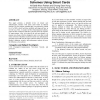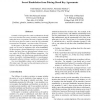13 search results - page 2 / 3 » Threshold Password-Based Authentication Using Bilinear Pairi... |
ICUIMC
2009
ACM
14 years 1 months ago
2009
ACM
This paper presents a detailed review of remote user authentication schemes with smart cards based on bilinear pairings. The first scheme regarding this was proposed by Manik et a...
SP
2003
IEEE
14 years 21 days ago
2003
IEEE
Consider a CIA agent who wants to authenticate herself to a server, but does not want to reveal her CIA credentials unless the server is a genuine CIA outlet. Consider also that t...
ISCI
2010
13 years 4 months ago
2010
Key agreement (KA) allows two or more users to negotiate a secret session key among them over an open network. Authenticated key agreement (AKA) is a KA protocol enhanced to preve...
ISCI
2008
13 years 7 months ago
2008
Directed signature scheme allows only a designated verifier to check the validity of the signature issued to him; and at the time of trouble or if necessary, any third party can v...
ASIACRYPT
2005
Springer
14 years 1 months ago
2005
Springer
We introduce a new cryptographic primitive called the blind coupon mechanism (BCM). In effect, the BCM is an authenticated bit commitment scheme, which is AND-homomorphic. It has n...


